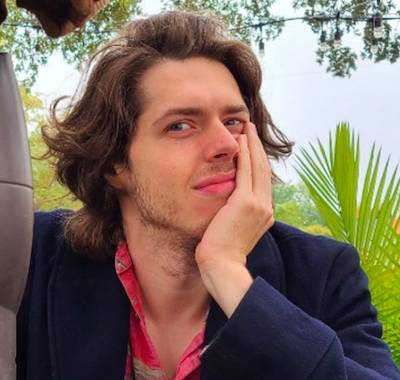Dressing Despair in Paradise With “The White Lotus” Costume Designer Alex Bovaird
The White Lotus costume designer Alex Bovaird, along with creator Mike White, wanted to make season three of the HBO show bigger and bolder than ever. Although it’s a longer season with more characters and more narrative complexity, for Bovaird, it still always comes down to researching reality and bending it from there.
Every season of The White Lotus has seen characters attempt to escape their own reality by descending upon another culture and failing to let go, adapt, or change in a variety of ways, sometimes with fatal consequences. Season three involved possibly the most disaffected and disregulated tourists yet—almost all of these monied outsiders are struggling with their lives, either unfulfilling or scarily nebulous, a kind of fear and loathing in Thailand, just in snazzier attire and with less hard drugs (although there are some hard drugs). There’s the Ratliff family, a five-top of confused beliefs, pill addictions, daddy issues (mainly via Patrick Schwarzenegger’s Saxon), and one very bad legal problem back home. You’ve got the sweet-and-sour couple, Chelsea (Aimee Lou Wood) and Rick (Walton Goggins), she’s the soulful searcher, he’s the wounded, irritable older man harboring explosive secrets that will build to one of the season’s biggest twists. And, rounding out the guest rotation this season was “the blonde blob”—Laurie (Carrie Coon), Kate (Leslie Bibb), and Jaclyn (Michelle Monaghan), longtime friends reuniting for an expensive, louche trip down memory lane that threatens to become a dead end for their relationships. Finally, there’s longtime White Lotus employee Belinda Brown (Natasha Rothwell) on a business trip of sorts; she’s down in Thailand for a crash course in Thai spa mentality, some luxury time with her son, and, it turns out, a run-in with her former would-be benefactor’s likely killer, Greg (Jon Gries).
Bovaird, whose work includes American Honey, Nope, and True Detective: Night Country, spoke with The Credits about her Emmy-contending work dressing these ne’er-do-wells, searchers, and schemers.
Let’s start with Rick (Walton Goggins). How did you decide to give Rick — maybe the most lost man on the show — the most comfortable wardrobe?
Rick has been living as an expat in Asia for some years. His wardrobe is typical of someone living abroad from America. We saw many guys like Rick in Thailand. His clothes should be comfortable, since he knows how to dress for the climate. There’s no fighting that heat — he’s sticky and sweaty, just like real life there. When we meet him, he definitely stands out and raises questions. Rick is running from something, and Chelsea is running towards something, and they’re just star-crossed lovers. They’ve been rocking around these Southeast Asian islands. Their costumes are old, dusty, and grungy. Most of their clothes are vintage, so they look different because they’ve been washed hundreds of times.
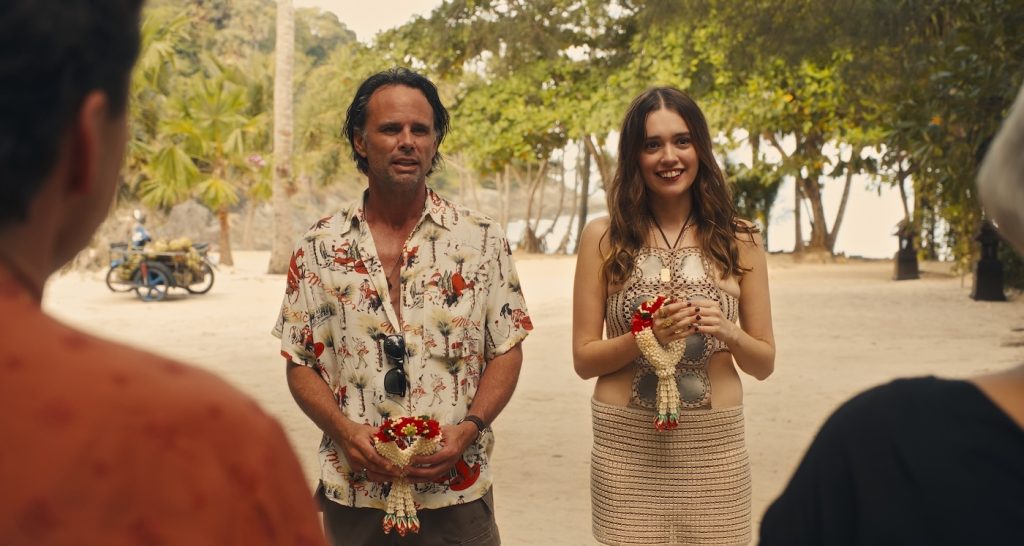
The Ratliff family (headed by Jason Isaacs and Parker Posey) is dressed spot-on when it comes to how high society dresses in that part of the country. How did you work to make them individuals, but still clearly part of the same family?
The Ratliffs think they are better than everyone else. I dressed the boys like typical rich kids from North Carolina. They love a brand called Southern Tide. It’s practical and not too flashy. The young men down there wear golf shirts; they aren’t too into fashion. Piper is more earthy, and she’s reaching for ground beyond her sheltered upbringing, so she wears a lot of modest cotton dresses. Tim [Isaacs] had a uniform of linen shorts and shirts, and Victoria isn’t interested in the ocean or the beach or getting out of her comfort zone—she’s strictly lounging in vintage kaftans and heirloom jewelry. They all make an effort.
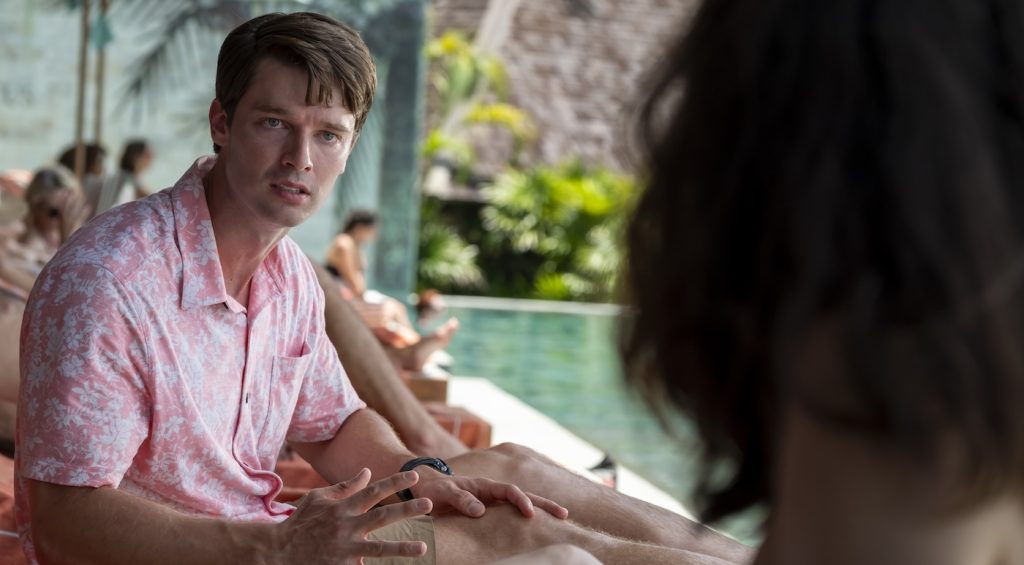
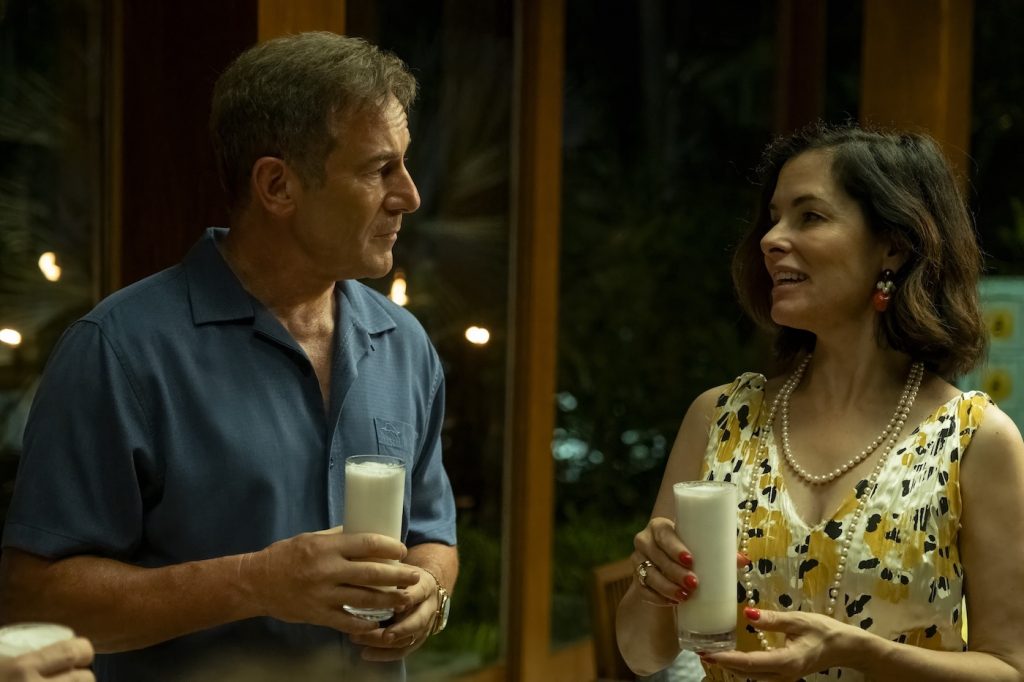
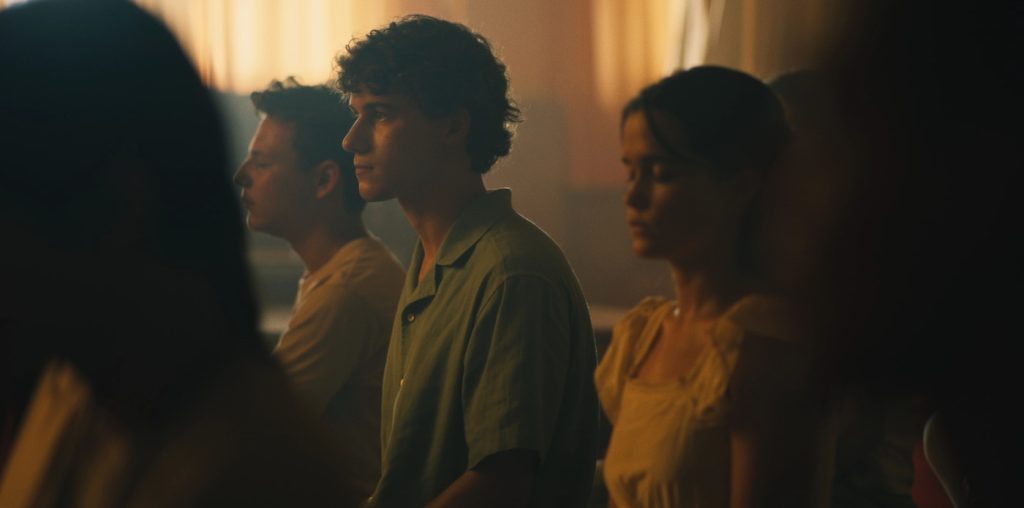
How much do you want the costumes to contrast with who these people really are?
There are quite a lot of people on The White Lotus who are posing — that’s part of the conceit of the character and the storytelling. There may be some armor going on with the bag-toting or hiding behind sunglasses or a big floppy hat, clutching a purse out of insecurity. What that purse may be, or how dramatic the sunglasses are, definitely helps to play into the idea of a mask — and masking who we are, using flamboyant costumes as armor.

When you first read Jaclyn, Kate, and Laurie on the page, where did your instincts go?
Jaclyn reminded me of actresses I’ve worked with and the group dynamic I’ve seen when ladies get competitive around the edges. I knew they’d be dressing for each other and upping the ante. As they settle in, we see who’s got the power and who is more fragile, and their outfits take cues from that.
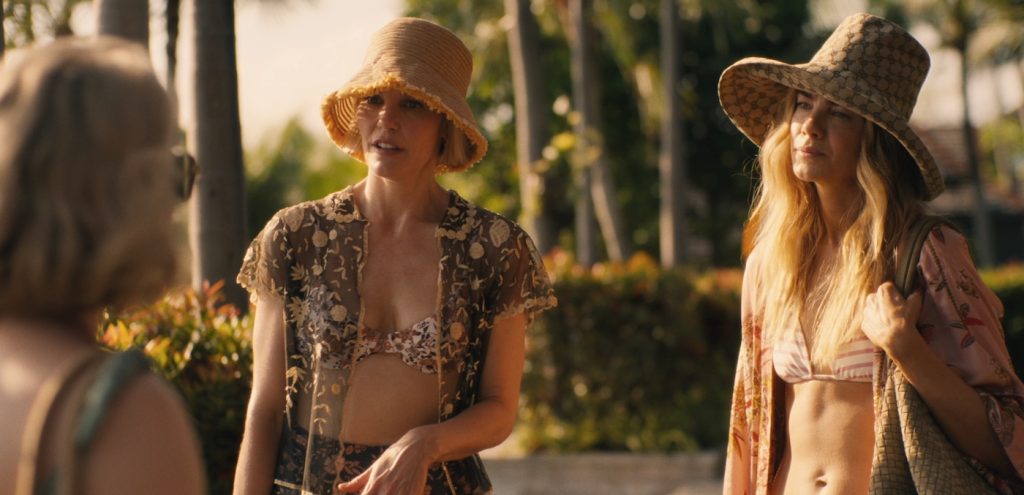
How did you want them to up the ante on one another?
It was almost designing one character with three heads, because they were slightly interchangeable. They were dressing for each other, all showing off a bit. They would wear colorful and fancy attire to the beach, especially when they arrived. They’re like, “Oh, look at my fabulous thing that I bought,” which can be very true to female behavior. We are in the business of generalizing sometimes when we want to make a point, but they had more bits and bobs than anybody else. They always had to have a good shoe, a different bag, and good earrings, because that was who they were. They were proving to each other that life was pretty good, even though some of them were crumbling.
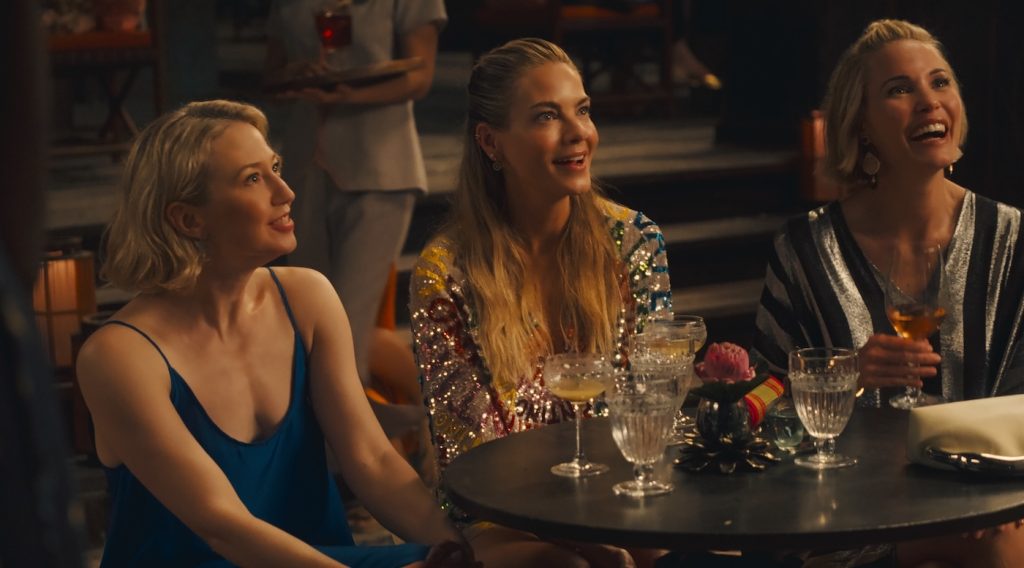
How did you approach their looks for the final dinner, when Laurie has that great monologue? How’d her truthfulness influence you?
Laurie is softer. She feels more comfortable. She is beautiful in that scene, wearing a silvery kaftan and expensive earrings. She’s throwing down the gauntlet and letting them know how she really feels. They’re all gorgeous in that shot. There’s a lot more to it that was cut. You see them back at the villa, too. There’s more catharsis with them bonding than just that little snippet. But they do their little camp routine that they’ve been talking about, that they used to do. They act it out, where one of them puts their hands through the other’s dress, and they do this little show. Some of the components of the costume were thought through [for that scene], so that would look good as well. The costumes were shiny and gorgeous, but we didn’t see as much of them [in the final cut].
On the page, does Mike White write many ideas about how the characters dress?
He told me that the Ratliffs look like they stepped out of a Ralph Lauren catalogue. He wanted them to look uniform and gorgeous. He also wanted the ladies to look like “a blonde blob.” I think the short swapping of Saxon and Lochlan was on the page. I love working with Mike, and we definitely have a shorthand now.
He shoots your costumes very lovingly, especially in wide shots. What do you appreciate when you watch your work through his eyes?
I get a kick out of seeing the entire costume, because it’s more gratifying than when you’re like, “Ah, all that work, and you can’t even see it.”
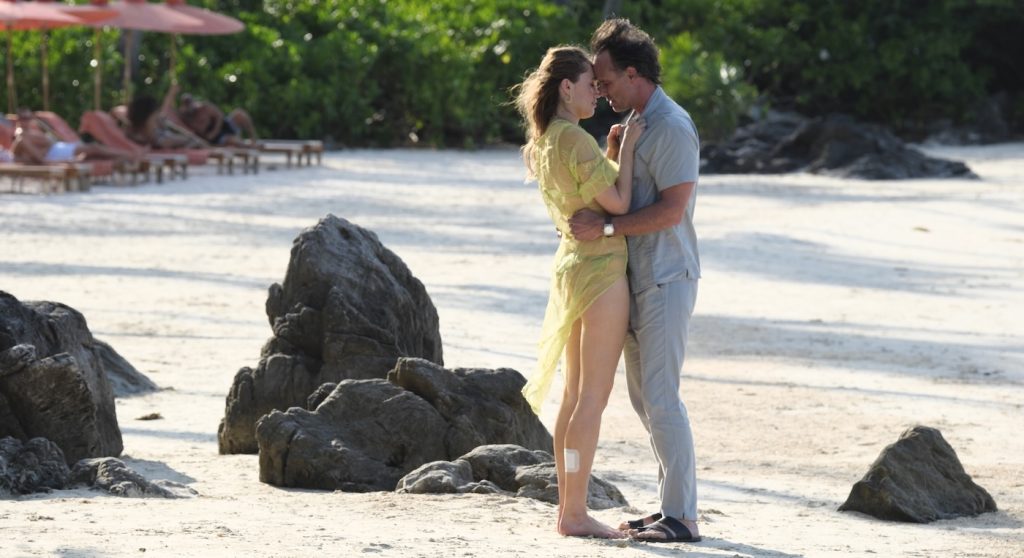
Many costume designers say, “Why is it all medium shots and close-ups?”
In season two, they used a lot of tracking shots, where you’re constantly following people in and out. Personally — not because you see more of the costume — I like to stay with the character, to be in the mind of somebody by following them. I found that sometimes in season three, we were static in the restaurants. I think that was a lot of logistics because the places we were shooting were up in almost, like, a treehouse. It was probably difficult to lay the track down sometimes, because of the windy paths. I’m contradicting you slightly, because you’re saying he shoots in a way that you see the costume so well. Ben [Kutchins], the same cinematographer from season two, lights beautifully, particularly for the colors, the costumes, and the background. I think everything looks more beautiful than it is, so I’m grateful for that.
Any members from the costume department you’d like to single out, sing their praises?
Oh my God, they were all good. I wouldn’t have survived without Julia, my assistant, because she was with me every step of the way. The Thai crew were amazing, and the set crew were the real heroes. They were watching the actors from dusk to dawn, keeping them comfortable, cool, and ensuring their costumes looked good. They have such dedication to preserving the costumes. My job is to create the outfits; it’s their job to maintain them on set. If you watch The White Lotus, in Thailand, people’s colors are pristine, their linen is pressed when we want it to be, and they did a tremendous service to my costume design by making sure the costumes look as good as they play.
Feature image: Walton Goggins. Photograph by Fabio Lovino/HBO


